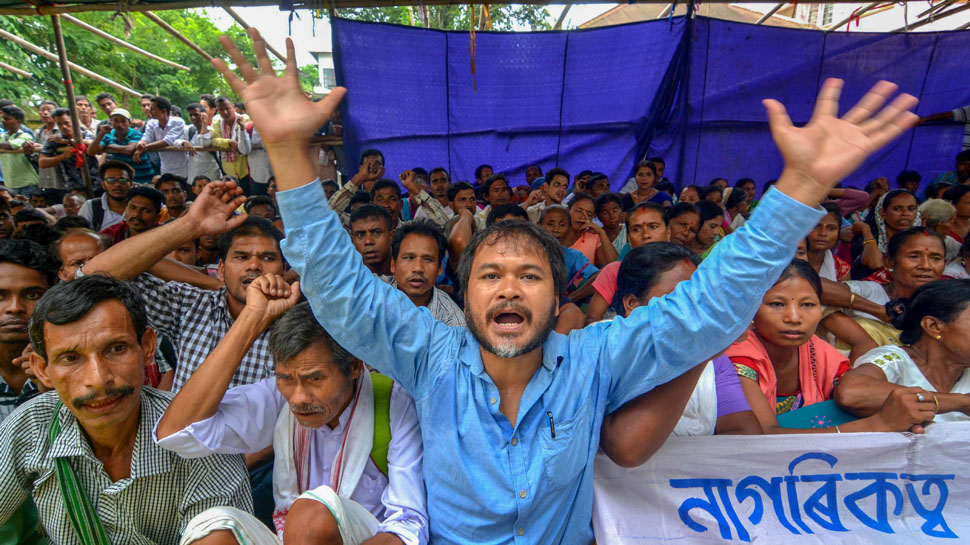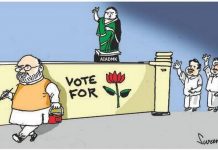THE CITIZENSHIP AMENDMENT BILL
The Citizenship Amendment Bill has generated widespread unease and protest in Assam as it proposes to leave a great part of the state’s population stateless and homeless. Will a democratic nation turn a deaf ear to the voice of the marginal?
Chandreyee Goswami is currently working in Gauhati university as a guest faculty in the Department of Sociology.

[dropcap]T[/dropcap]he entire state of Assam is currently going through a torrent of uncertainties, anxiousness and an absolute mess. It is because of the passing of the Citizenship Amendment Bill in the Lok Sabha on 8th of January, 2019 after receiving green signal of the Joint Parliamentary Committee (JPC) formed to examine the different aspects of the bill. However, it is being argued that the decision of the JPC was not an unanimous one leading to protest by opposition MPs including Congress and CPI due to the adoption of the report without effective discussion In this context, the question that acquires utmost relevance is what is the Citizenship Amendment Bill (CAB) and why it has created a stir across Assam.
With regard to the former question it is incumbent to understand the Citizenship Act, 1955 which is to provide for acquisition and determination of Indian citizenship. It contains definitions of illegal immigrants and prescribes the four main methods of acquiring citizenship, that is, by birth, by descent, by registration and by naturalisation. Additionally, to accommodate the growing overseas Indian population, at the turn of the millennium, Parliament introduced the concepts of Persons of Indian Origin(PIO) and Overseas Citizen of India(OCI) and granted them certain limited citizenship rights through an amendment made in 2005.
The proposed amendment in this regard, sought o bring the following changes (Thakur, 2018)
(i) Persons belonging to minority communities, that is, Hindus, Jains, Sikhs, Buddhists, Parsis, and Christians from Afghanistan, Bangladesh, and Pakistan shall not be treated as illegal immigrants.
(ii) The third schedule of the 1955 Act is proposed to be amended to decrease the residence requirement from 11 years to six years.
(iii) OCI card holders are susceptible to lose their status if they violate any laws of the country.
It is primarily the first proposed change that has drawn several criticisms from different quarters both within and outside Assam. It directly delves into the question of granting citizenship to illegal immigrants which has been ostensibly the epicenter of different contestations in the state for many decades .But what is more odious is painting a communal colour on it by excluding the Muslim immigrants from the amendment. It is not only a prejudiced stance against a particular community but also a negation of the principle of secularism as espoused in the Constitution. The theory of “basic structure” states that the Constitution contains certain characteristics that cannot be taken away by any legislation. For example judicial review, free and fair elections, welfare state. These form the cornerstone of the governance of a country. Therefore, any legislation that fails the test of basic structure is unconstitutional. Secularism is a basic structure as has been reiterated by the Supreme Court in S R Bommai v Union of India(1994) case. It has also been incorporated in the Preamble to the Constitution which serves as the guiding light in interpreting the Constitution (Thakur, 2018). Thus, this bill is outrightly unconstitutional and if passed can be nullified. Therefore, the question arises that why the government is so keen on passing the bill which is bound to face many challenges and infringe the Constitution.
At this juncture, it is also imperative to understand why the bill has created such a conundrum particularly in Assam but not so in other parts of the country despite its unconstitutional character. It requires atleast a pithy understanding of the vitality of the immigrant issue in the context of Assam viz-a-vis Bangladesh.In this regard, it is crucial to look at the socio-historical context of Assam and its relation to the Indian state to grasp the ground realities. Migration is not a new phenomenon in Assam. Rather, at different junctures of time, various communities have set their foot in this land and settled here. The Ahoms for instance who ruled Assam for around 500 years came from the northern and eastern hill tracts of Upper Burma and Western Yunnan.
However, as a part of invasion and accession strategies of dynasties, the Ahoms too extended their empire and made Assam their homeland. But at that time the western notion of nation-state was not introduced which latter was going to be definitional for the identity of India. The arrival of colonial rulers led to the ‘we’ feeling which is essential for any community to turn into a nation-state. However, one should not mistake the creation of this sense of belongingness to be organic. Rather, it is a result of the European quest to familiarise themselves with what they regarded as the ‘other’ leading to the construction of the ‘orient’ based on certain investigative modalities like the census ( (Cohn, 1996).
The Making of ‘Asamiya’ Identity
In such a background, at another level, a consolidation of regional identity was also taking place. The construction of ‘Asamiya’ identity and Assam in general can be seen as the consequence of these notions of nation, state and the people. As the Ahom rule got weakened due to internal contradictions, it paved the way for Burmese invasion and latter the arrival of British in Assam. The British in pretext of saving Assam from Burmese army conquered it making it a part of British India in 1826 thereby linking it with colonial capitalist world economy. However, the existing Ahom bureaucracy did not fit into the modern bureaucratic structure of the colonial rule. The British colonizers also had no intention of educating the Assamese immediately in order to ensure their continuity in the new colonial set up.

This in turn delayed the process of formation of a western educated middle class among Assamese. Therefore, it explains the import of ‘Baboos’ from neighbouring Bengal to recruit in the junior level positions of the colonial administration in Assam. It is important to understand that the British colonised Bengal much earlier and a new middle class emerged with the expansion of western education in Bengal presidency from the Bengali Hindus mainly drawn from the upper castes .In the absence of an Assamese middle class in the early colonial Assam, the Bengalis, largely Hindus monopolised nearly all jobs meant for the Indians in the colonial administration.
This eventually led to their domination in all aspects, most visibly with the question of language. For their administrative convenience, the British authorities introduced Bengali in the schools and courts of Assam. This replacement of language resulted in a sense of animosity between what latter would be defined as the two linguistic communities of Bengalis and Assamese(Hussein,1989). Therefore, one of the causes cited by various scholars for the emergence of a consolidated ‘Asamiya’ identity amongst the otherwise heterogeneous and segmented communities was an assertion of autonomy and distinctiveness of Assamese language and culture against the British colonial view of Assam as a periphery to Bengal.
Context as Premise to Progress
This understanding of the historical context is important to locate the current impasse in the state. Though the debates around the Citizenship Bill have been more about the illegal immigrants specifically from Bangladesh, one cannot have unilateral approach towards the whole issue. We have to understand that the entire issue of ‘Asamiya’ identity and its relation to safeguard it from monopolization of the ‘outsiders’ stems from the political economy which the British constructed for the continuation of their reign. For instance, since Assam was thinly populated during 19th century, therefore, the British had to directly or indirectly patronised migration of peasants from thickly populated East Bengal to Assam’s waste land. This was all to generate more land revenues and profit the ‘crown’.
Besides, the post-independence period also witnessed a neo-colonial hegemony in the form of Indian state. Despite being abundant of resources Assam’s economy continued to be stagnant. It is because Assam was denied the share of what it produced. For instance, many of the tea estates were transferred to big industrialists and as result of concealment of real profits, Assam who was entitled to get 60% of the profit had been deprived of it. Therefore, the unwillingness to attend to and the failure of political leadership of post colonial India in developing the economy and infrastructure of Assam caused anguish amongst the masses which accumulated and burst out in the form of Assam Movement. Though the movement was for the detection and deportation of the illegal migrants but the larger context of Assam being ignorant within the Indian state is significant to take into cognizance. Thus, the economic underdevelopment of the state along with assertion of autonomy and distinctiveness accentuated by heavy immigration were the major themes in Assamese ‘sub-nationalism’ (Baruah, 2005).

The Assam Movement which began in 1979 under the leadership of All Assam Student’s Union(AASU) and All Assam Gana Sangram Parishad(AAGSP) ended on 15th August 1985 after coming into an understanding with Government of India which found official expression in the Memorandum of Understanding popularly known as Assam Accord of 1985. This Accord led to an amendment in the Citizenship Act whereby it inserted an exception for Assam in the Act by setting the cut off date for Assam as March 24, 1971 instead of July 19,1948 which is the cut off date for the rest of India for acquiring citizenship.The movement once again brought the issue of illegal infiltration, the question of Asamiya nationality linked to politics of identity and the position of Assam in particular and other states of northeast in general in the Indian Union to the forefront
At that time many felt unsatisfied as they saw the accord as a blithe attitude of the government and a compromise made by the student leaders downplaying the years of struggle.Nevertheless, the accord was perceived as a harbinger of a new Assam, espoused by the then AASU leadership. With this semblance of hope and credibility, a motley of these leaders joined electoral politics under the banner of what came to be known as Asom Gana Parishad. However, it is very unfortunate that soon after coming to power the leaders totally sidelined the issue for which they were primarily being elected by the people. As a consequence, they suffered a crushing defeat in the latter elections and eventually lost the trust of the people. Meanwhile, the downfall of AGP paved the way for Congress to regain its lost glory and install government. At this juncture , it is important to understand that it is the same party under whose tenure the two main agitations relating to the question of ‘Asomiya’ identity namely Language Agitation and Assam Agitation took place. It is very ironical that the party which today has left no stone unturned to vehemently criticise the present government for initiating the controversial amendment to the bill has itself played a cardinal role in pervading and exacerbating the given issue for reaping benefits through the vote bank politics. Therefore, when they impugn the current regime of giving a communal tangent to the bill, it is imperative to take into account that since independence the manoeuvring of votes in the name of religion by the then single largest party is also an incontrovertible fact. Assam is no exception in this case.
Besides, following the signing of the accord both the Congress government at the centre and the state and latter the AGP government had the opportunity to look into all three of the above mentioned matters and pitched for its effective resolution. However, the very structure of a nation state does not leave room for looking at substantive interrelationships. Rather, as Sanjib Barooah in his book ‘Durable Disorder’ argued, “The modern nation state seeks a monopoly of the collective imagination of all its citizens. It would like the state defined broad political community to be the sole repository of the poetics of a homeland and the memories and dreams of a people defined singularly even there may be gestures towards acknowledging diversity.”( (Baruah, 2005) India too, to a great extent followed the same pattern. Its fire-fighting approach to tackle any form of dissent and dissatisfaction or divergence has done more harm than good. Consider the Assam accord. The accord was a palliative response to a pivotal issue leaving an array of questions unanswered thereby creating qualms in the society whose repercussions we are facing today. What is more disheartening is the lacklustre attitude in fulfilling the demands put forward in the accord. On one hand Delhi had no time to spare for a state and a region so inconsequential for electoral vote game and on other hand Dispur was either too busy to woo their high command in Delhi or too captive in fulfilling their own political aspirations. These unfulfilled promises cleared the political space for the intensification of militant activities with the rise of United Liberation Front of Assam(ULFA) ready to avenge the perceived deception to the Assamese people by the central government (Baruah, 2005).
Besides ,in these years the social distance amongst different ethnic and religious communities on one hand and between them and the Hindu middle class Assamese on other have also widened as they felt peripheral in the entire process of negotiation between the Centre and the student representatives. Further, the hegemonic tendencies of the Assamese ‘ruling class’ which marked the socio-political scenario of the state have had also contributed to the feeling of atomisation. It is very interesting that how our identities are not singular but have layers into them. Similarly, the perceived ‘Asamiya’ identity has many layers and gets entwined with class, ethnicity, caste and gender. Therefore, the question remains that whether the reiteration of this Asamiya identity is an inclusive one or does it echoes a dominant notion of Asamiya identity representing the Assamese ‘dominant class.’ (Srinivas,1987)
The Issues of Illegal Migration
Today when the entire issue of illegal immigration from Bangladesh has surfaced in the form of Citizenship Amendment Bill, it seems that we have come back to the same point from where 23 years ago we were shown the hope of building a ‘Golden Assam’. Once again the question of illegal foreigners, ‘the Asamiya identity and our relation vis-a- vis to the centre have reemerged. The first two matters are intrinsically related to each other. It is because over the years it has been recounted that the illegal immigrants are a threat to the social, cultural, political and economical life of the indigenous people (Khilonjiya as called in Assamese). In this context, two things become pertinent. One is to carefully examine all the aspects of the infiltration problem and the other pertains to defining what is ‘indigenous’ or Khilonjiya with regard to Assam. However, neither of these matters which were infact also been included as part of different clauses of the Assam Accord have had gauged up seriously in these many years.
Instead, the present regimes by overlooking the existing complexities in relation to the aforementioned matters have undertaken a completely detrimental and lopsided step. By acceding to grant citizenship to the religious minorities but Muslims from Bangladesh along with other countries, it has not only jeopardised the secular character of the country but also prodigiously disrespected and betrayed the trust, emotions and the struggle of people of Assam. This amendment is an outright mockery to the six year long bloody Assam Agitation and an unalloyed negation of the Assam Accord. Moreover, it would also deem the tedious and humongous process of updating the National Register of Citizens (NRC) redundant.
But, it seems that neither the central nor the state government has any intention to pay heed to the ‘public opinion.’ In this context, coming back to the very first question of government’s urge to pass this controversial bill acquires relevance. The BJP government contends that the bill is crucial as it would help the given religious minorities who have faced persecution in their respective countries to resettle. In addition they also claim that by bringing Bengali Hindus they are safeguarding the interest of the indigenous people of Assam. These kind of arguments put forward by the ruling party is very unfortunate in a democratic and secular state like India which needs to be trenchantly condemned and opposed. Besides, the deafening silence of the political representatives of the state government including the Chief Minister, most of whom earlier identified themselves with the regional polity have immensely disappointed the people for not standing up for the cause of their community.
Nevertheless, in the midst of these deliberations, one should not forget that the general elections are just at the doorsteps. The election calculations serve us the answer to the impetuous attitude of the government to pass the bill. From this perspective, it seems that the bill is nothing but an election gimmick to attract voters particularly the Hindus to secure a clear mandate in the eastern part of the country. In this context, seemingly Assam has again been reduced to a pawn by different political players to meet their own interest and to increase their probability of winning the great battle of 2019. Meanwhile to pacify the people and subside the growing agitation, the announcement of the government to implement the clause 6 of Assam Accord to provide constitutional, legislative and administrative safeguards to protect, promote and preserve the cultural, social ,linguistic identity and heritage of the Assamese people and to extend the Scheduled Tribe status to the communities of Koch Rajbanshis, Tai Ahom, Chutiya, Matak, Moran and tea tribes comes as no surprise. It is to be understood that these have been protracted demands of the people which were never taken up sincerely. These tactics evinces that how indiscreet and desolate their approach is towards the criticality of the entire issue. In the hindsight, what is being forgotten is the fate of those whose names have not appeared in the NRC. Being a democratically vibrant country, the question arises that can we afford to render so many people stateless. In this context, another question that emerges, why till date there has not been any diplomatic as well as political discussion with the Bangladesh government on this matter. Amidst these questions and complexities, when the Citizenship Bill proposes changes in terms of religious biasness, it is susceptible to produce a tumultuous response.
At this moment, few lines from Bhupen Hazarika’s song may show light in these gloomy times. The song was composed by Hazarika in 1968 which is a continuation of a poem by late nineteenth and early twentieth century literary stalwart Lakhminath Bezbaruah. It begins as, “We Assamese are not poor. In what sense are we poor? Hazarika’s song starts by referring to the word’s in Bezbaruah’s poem and then continues as: “It won’t do to take solace in the words that we Assamese are not poor; today’s Assamese must know themselves (become self-aware as a people),or else Assam will be doomed.” (Baruah, 2005).In consonance with these lines, it is a prayer that the current turmoil makes the people of Assam retrospective of their actions and identity so that no power can supersede and hijack their dissent and that they uphold their dignity and the true spirit of democracy for the posterity.














